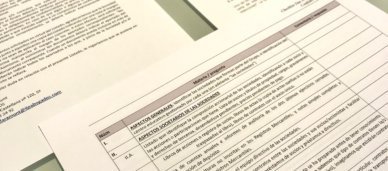
19.02.2025
EU Regulation 2020/852: “EU Taxonomy”
The EU 2020/852 Sustainable Investment and Enabling Framework Regulation (colloquially known as the "EU Taxonomy") establishes uniform criteria for determining whether an economic activity is considered environmentally sustainable. The main objective is to facilitate sustainable investments and prevent "greenwashing". The regulation defines six key environmental objectives and requires transparency on the part of financial market participants and large companies. It seeks to redirect capital flows towards economic activities that contribute positively to these objectives, thus promoting a more sustainable economy throughout the European Union.
 Por
Sanz González , María
Por
Sanz González , María Chronology (Background)
- December 2016: the European Commission commissions a high-level expert group to define an overall EU strategy on sustainable finance.
- January 31, 2018: The expert group publishes a report advocating the creation of a Union-wide classification system to define “green” or “sustainable” activities, starting with climate change mitigation.
- March 8, 2018: The Commission publishes its “Action Plan: financing sustainable growth”, which initiates an ambitious and comprehensive strategy on sustainable finance. The plan stresses the need for a unified classification system for sustainable activities.
- June 20, 2019: The Commission publishes “Guidelines on non-financial reporting: Supplement on climate-related information”, recommending large companies to report on climate-related key performance indicators based on the framework of the future Regulation.
- June 18, 2020: Regulation (EU) 2020/852 of the European Parliament and of the Council, known as the “EU Taxonomy”, is adopted.
- July 12, 2020: The Regulation enters into force (20 days after its publication in the Official Journal of the European Union).
- January 1, 2022: Beginning of the application of certain provisions of the Regulation, in particular those related to the environmental objectives of mitigation and adaptation to climate change.
- January 1, 2023: The application of certain provisions of the Regulation begins, in particular those relating to the environmental objectives of sustainable water use, transition to a circular economy, pollution prevention and protection of biodiversity.
What is the main purpose of Regulation (EU) 2020/852, also known as EU Taxonomy?
The main purpose of the Regulation is to establish a unified classification system (a “taxonomy”) at the European Union level to determine which economic activities can be considered environmentally sustainable. This aims to redirect capital flows towards sustainable investments, prevent greenwashing, improve transparency and comparability of financial products, and facilitate the achievement of the Sustainable Development Goals (SDGs) in the EU.
To whom do these regulations apply?
The regulation applies to:
- Measures adopted by Member States or the EU that establish requirements for financial market participants or issuers with respect to financial products or corporate bond issues that are offered as environmentally sustainable.
- Financial market participants offering financial products.
- Companies that are subject to the obligation to publish non-financial statements or consolidated non-financial statements in accordance with Directive 2013/34/EU.
What are the six environmental objectives defined in the Regulation?
The Regulation defines the following six environmental objectives:
- Climate change mitigation.
- Adaptation to climate change.
- Sustainable use and protection of water and marine resources.
- Transition to a circular economy.
- Pollution prevention and control.
- Protection and recovery of biodiversity and ecosystems.
How do you determine whether an economic activity contributes substantially to an environmental objective?
An economic activity is considered to contribute substantially to an environmental objective if it meets the following criteria:
- Substantially contributes to one or more of the defined environmental objectives.
- It does not cause significant detriment to any of the other environmental objectives.
- It is carried out in compliance with minimum social and governance guarantees.
- Meets the technical selection criteria established by the European Commission.
What are “technical selection criteria” and who defines them?
Technical screening criteria are specific criteria, defined by the European Commission through delegated acts, which determine under what conditions an economic activity is considered to contribute substantially to an environmental objective and does not cause significant harm to other objectives. These criteria are quantitative or qualitative and are based on scientific data and existing EU regulations.

Si te ha interesado este artículo no dudes en leer:
Is Your Company Complying with Sustainability Regulations? Discover the Answers to Your Most Frequent Questions Before It’s Too Late!
What does the Do No Significant Harm (DNSH) principle mean?
The “no significant harm” principle (DNSH) means that an economic activity that contributes to one environmental objective must not significantly harm any of the other five environmental objectives. The European Commission also defines technical screening criteria for this principle. The assessment of DNSH is based on the life cycle of the products and services generated by the activity.
What are transition and facilitating activities?
The Taxonomy Regulation recognizes the importance of transitional activities that contribute to climate change mitigation (whose greenhouse gas emissions are well below the sector or industry average, do not hinder the development and deployment of low-carbon alternatives, and do not entail the retention of assets incompatible with the goal of climate neutrality), even if they are not entirely low-carbon, provided they support the transition to a climate-neutral economy and do not hinder the development of low-emission alternatives. It also identifies “enabling” activities that allow other activities to contribute substantially to environmental objectives.
What is meant by Circular Economy?
circular economy means an economic system in which the value of products, materials and other resources in the economy lasts as long as possible, enhancing their efficient use in production and consumption, thereby reducing the environmental impact of their use, and minimizing waste and the release of hazardous substances at all stages of the life cycle, where appropriate through the application of the waste hierarchy.
What is meant by Waste Hierarchy?
The following waste hierarchy will serve as an order of priorities in legislation and policy on waste prevention and management: (a) prevention; (b) preparation for reuse; (c) recycling; (d) other recovery such as energy recovery and disposal
What are the implications of this Regulation for companies that are required to publish non-financial information?
Companies required to publish non-financial information must include in their non-financial statements information on how and to what extent their activities are associated with economic activities that are considered environmentally sustainable. This includes the proportion of their turnover, fixed assets and operating expenses related to sustainable economic activities.
How will these regulations be reviewed and updated?
The European Commission will publish a report on the implementation of the Regulation every three years, starting on July 13, 2022. This report will assess progress in defining technical criteria, the need to review the sustainability criteria, the use of the definition of sustainable investment in EU and Member State legislation, the effectiveness of the technical criteria in channeling private investment, and access to verifiable information on companies.
If you liked this article, you may also find it interesting to read the following one:
M&A and the Circular Economy: A Perfect Marriage for a Sustainable Future
Contacto No te quedes con la duda, contacta con nosotros. Estaremos encantados de atenderte y ofrecerte soluciones.








